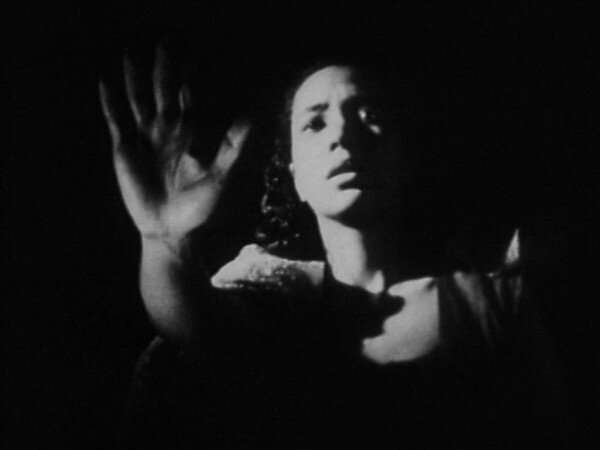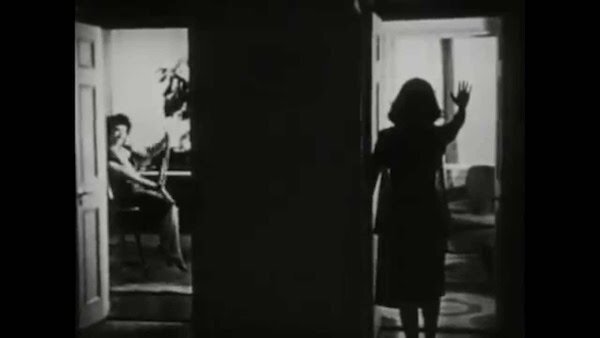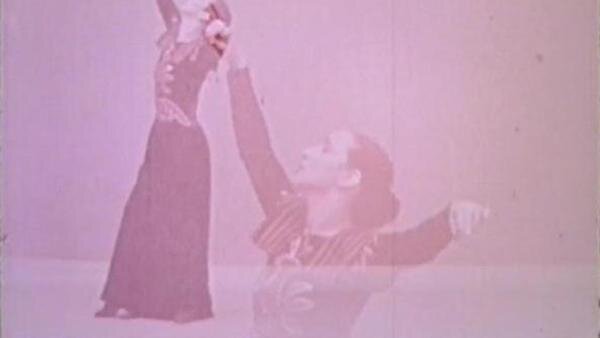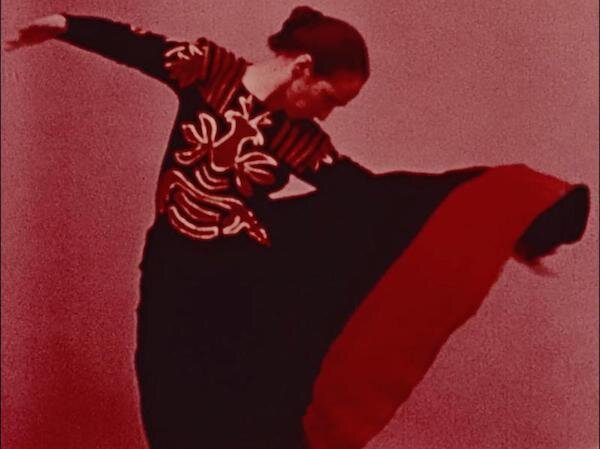In times of physical uncertainty and global upset, it is important to reconnect with the body and its most basic forms of movement. The seminal dance films of experimental artists Shirley Clarke and Maya Deren showcase the way choreography and performance can speak to a vivid understanding of bodies. Through Ritual in Transfigured Time and Bullfight, Madeleine Seidel wrestles with what dance truly can achieve.
The body feels more fragile than ever. We are living through a moment where premature death runs rampant, not only hurting the physical body, but our relationships to one another and our sense of security. The natural and inevitable end of ourselves is a difficult subject to broach in the best of times, but amidst the COVID-19 pandemic – and incessant violence brought on through economic and racial injustices – the decay of the body has a frightening resonance. Pivotal figures in the birth of American experimental cinema, filmmakers Shirley Clarke and Maya Deren explore our bodies’ relationships to time and physical disintegration in their short features Bullfight and Ritual in Transfigured Time. Through choreography and cinematography that tests the limits of human physicality, Clarke and Deren use the dance film to explore the ephemerality of the body in a beautiful, radical way that challenges preconceived notions of movement and time in cinema.
Best known for surreal short film Meshes of the Afternoon, Deren was an active figure in the experimental film communities of the United States. Her best-known short features are strange and beguiling, addressing mysticism, anthropology and women’s issues through choreography. Before devoting herself to her filmmaking practice, Deren worked as an assistant for legendary dancer and choreographer Katherine Dunham, and her work for Dunham inspired her most ambitious project, Divine Horsemen: The Living Gods in Haiti. Like Deren, Shirley Clarke began her artistic practice in dance, before turning to filmmaking in the early 1950s. Although her later films such as The Cool World would be gritty docudramas about race and city life, her early shorts were anchored by experimental choreography.
As with any other recorded performance, questions of viewership and the gaze within dance film is essential: are we as an audience able to properly understand movement (performance art, body art, dance) when privy only to recordings, rather than being in the room? Although appearing as truthful representations of an event or object, the photograph and the moving image are not neutral sites. In documentations of performance, the camera serves as a mediator between the experience and spectator, filtering movement and emotion through technology and the biases of the operator. The creator’s gaze profoundly affects the meaning of the recorded experience and in the most extreme cases, can distort an event far beyond its origins. Art historian Amelia Jones’ essay “‘Presence’ in Absentia: Experiencing Performance as Documentation” addresses how archival recordings can be used in performance research. Jones begins by addressing criticism of her work by art historical colleagues that argue her analysis is incomplete, because she did not witness the historical performances she studies. Jones posits the opposite in response: “[it] is my premise here, as it has been elsewhere, that there is no possibility of an unmediated relationship to any kind of cultural product, including body art. Although I am respectful of the specificity of knowledges gained from participating in a live performance situation, I will argue here that this specificity should not be privileged over the specificity of knowledges that develop in relation to the documentary traces of such an event.” Clarke and Deren’s dance films were not intended to be experienced live (as is the case with the works Jones analyzes) and were choreographed for camera, but the sentiments that Jones applies to documents of live performance can be applied to this specific dance film context. Meaning is created directly through Clarke and Deren’s cinematic interventions, not necessarily from the performance itself.
Douglas Rosenberg’s Screendance: Inscribing the Ephemeral Image applies discussions of mediated images and performance documentation to the work of experimental directors capturing dance and human movement. In the text, he theorises that there are essentially two types of dance films: documentation and “screendance.” Whereas documentation is a straight recording of movement, screendance is “the articulation of choreographic ideas completely contingent on the specificities of media space.” Screendance also uses cinematic techniques and framing to warp performers’ physicality to “impossible” lengths through what Rosenberg calls recorporealisation, or “the literal reconstruction of the dancing body via screen techniques; at times a construction of an impossible body, one not encumbered by gravity, temporal restraints, or death.”
In Deren’s Ritual in Transfigured Time and Clarke’s Bullfight, screendance and recorporealisaton are performed in reverse, allowing Deren and Clarke to directly confront the limits of physicality to the haunting conclusion of death. At the beginning of these two features, the bodies on screen are in defiance of natural law and placed in impossible, unlimited spaces. In Deren’s Rituals in Transfigured Time, we see dancers interacting with each other in different dreamlike spaces with little explanation as to how they got there in the first place. The film opens with a maze-like domestic setting, featuring three women (Rita Christiani, Anaïs Nin, and Deren herself) performing seemingly mundane tasks. Christiani and Deren are transported to another room, where a hazy and crowded gathering is taking place. Christiani, the younger of the two female dancers, is inexplicably wearing a mourning outfit of a black veil, rosary, and a calla lily bouquet. She moves through the mass of partygoers with little aim or consequence with small physical interactions like handshakes punctuating the scene. In another quick cut, Christiani and some of the people she interacted with at the party have moved to a garden. The lone man in the group (Frank Westbrook) is dancing and leaping amongst the garden’s Greco-Roman ruins and statues, with the gaze lingering on the musculature of his shirtless torso. Now out of her funerary attire, Christiani joins him, and Deren’s camera captures the two frolicking in the garden at an angle that frames these two dancers against the clear sky, which gives the illusion of flight and physical dominance. For a moment, these two bodies are invincible, dancing amongst nature in a way that makes them seem so powerful as to be immortal––an act of recorporealisation in the truest sense.
Bullfight’s frenetic cinematography and choreography also establish a supernatural sense of agency and omnipotence for its two main characters: a bullfighter and a dancing woman, played by the choreographer Anna Sokolow. The short feature consists entirely of quick cuts between the bullfight and the dancer. Dressed in full regalia amongst cheering fans, the bullfighter himself is seen in the opening footage as a gloriously untouchable figure: yes, the bull poses a danger to his physical body, but in this ritual, he is protected by the privilege, tradition, and power afforded to him by his masculine physical body. Sokolow’s dancer is similarly dressed in traditional garb, but she is all alone. Her physical presence––highlighted by Clarke through close-ups on her neck and head––draws a comparison to the movements of the man in the arena. The beauty and bodily limitations in Sokolow’s dancing are in stark contrast to the power of the man in the arena despite the riskiness of his actions.
After moments of god-like power, the impossible spaces and bodies in Ritual in Transfigured Time and Bullfight quickly begin to unravel. In Bullfight, the once-proud bullfighter is wearing thin, realizing he may lose his battle. The dancer and the bullfighter move in tandem, until the camera lingers on Sokolow’s passionate dancing. When Clarke’s camera cuts away from Sokolow, the bull strikes the bullfighter. Sokolow’s dancing now reflects the bullfighter’s injured state as she flails her arms and falls on the ground. Cinematographer Peter Buckley turns to the crowd and focuses on a woman, who appears to be Sokolow, turning her face away from the tragic scene. In a dramatic flourish, the bullfighter rises and fatally injures the bull, ending the fight and allowing the bullfighter to walk away with his life barely intact. While Bullfight does not end in human death, it still offers a compelling look at the peril the human body can survive––and the foolhardy lengths we will go to prove our power over nature––by using dance film structures to challenge recorporealisation.
Recorporealization is challenged in a more permanent way following the climax of Ritual in Transfigured Time. After Christiani and Westbrook’s triumphant garden dance, the man’s actions quickly become menacing. He uses his strength to scare the remaining women and blends into the pastoral scene by mimicking the statues. With Deren’s character watching sombrely from a remote location invisible to the other dancers, the young woman is ambushed by the man, and he chases her out of the garden and to a dock, where she runs off the cliff and drowns. The spell of immortality, achieved through Deren’s camera and choreography that showcased the dancers’ bodies in illusionistic ways, is broken in the young woman’s death. The physical body is as much a part of recorporealisation as it is death, and in this death, we can reflect on how limitations make the beauty of the human body all the more powerful, even if physicality alone is not powerful enough to stop decay.
Maya Deren’s Ritual in Transfigured Time and Shirley Clarke’s Bullfight see value in destruction. Through the camera and choreographed movement, they capture dance on film and achieve recorporealisation, only to tear it down to its tragic end in their films’ final moments. It is a bold and radical means of filmmaking to use physicality as a way to lean into the supernatural and what is undeniably human, caught in the constraints of gravity and flesh. By surpassing the documentary aspects of the dance film, Deren and Clarke offer a look at mortality that is at once unnerving and beautiful, seeing the body––flawed and fragile as it may be––as a site for miraculous potential and beauty, while Death waits in the next frame.
Madeleine Seidel (@mhllndrivethru) is a freelance arts writer and curator based in Brooklyn with bylines at The Brooklyn Rail, Little White Lies, and BURNAWAY. She is a current Masters candidate at Hunter College and has previously worked at the Whitney Museum of American Art. Her current research interests include American feminist art movements in the 20th century, curatorial practices in film exhibition, and the art of the American South, especially art from her home state of Alabama.





